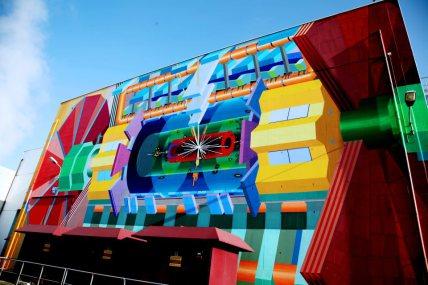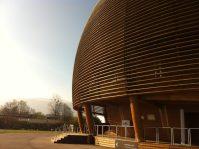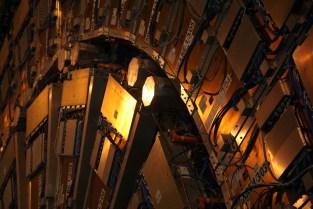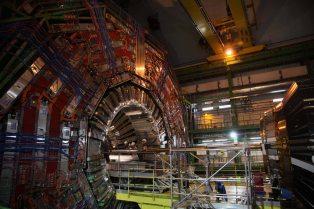Not content with crossing the borders of human understanding of the fabric of the space and time by smashing subatomic particles together in order to reconstruct what happened in the first trillionth of a second after the big bang, those clever guys and girls at the European Centre of Nuclear Research (CERN) have also found the time to organize some extraordinary events over the past 12 months.
Back in the last spring last year, Rich Pickings was given the opportunity to participate in the third edition of the Cineglobe International Film Festival. Held in and around CERN, this festival is organised by a hugely enthusiastic crew of cineastes, working around their day jobs as particle physicists. Needless to say, this makes for a rich and unusual festival experience. The main venue was the beautiful ‘Globe of Science and Innovation’, an astonishing spherical wooden structure somewhere between cathedral and ski chalet. The programme was ‘inspired by science’ and themed ‘Infinitely Interconnected’. From the very small to the very big, it explored cause and effect connections across the universe and human society.



Rich Pickings brought two events to the festival. The first was a programme of short films dealing with time travel and parallel universes, curated for an audience of teenagers. The second Rich Pickings event, aimed at an adult audience, explored the subject of collaborative creativity in film.
Although science and technology were always in the air at Cineglobe Festival, the language and atmosphere was never overly technical. The focus was not on the details but rather on the intentions and motivations of science: the desire to explore and understand, the wonder of discovery. I left CERN last summer with the bug to find out more about the scientific view on the biggest and smallest things in the universe. So I was delighted when I got the news that CERN were organising another event, this time under the TEDx banner. TEDx events are independently organised events which follow the format of TED talks. The events are put on by volunteers and usually offer some interesting insights, though the quality of content and event production varies wildly between organisations. TEDxCERN took the theme ‘Multiplying Dimensions’ and promised to ‘reach beyond particle physics’ to inspire people of all ages. It did not disappoint. The day’s talks included scientific history, analysis of recent breakthroughs and fiercely opinionated, well-informed rants. One of the latter was John Searle‘s talk on consciousness in which he defended the idea of it as a bioloigical process which must be studied as such. He dismissed notions of consciousness as a spiritual phenomenon, an illusion or an unknowable subject as absurd, offering convincing and entertaining arguments to support his opinions.
Several of the talks looked at ideas of networked innovation, crowds and clouds and new ways of dealing with big data. Lee Cronin‘s talk Networking Chemistry put forward a vision of a world where professional and domestic labs could be networked into an experiment the size of CERN working towards one outcome: the creation of life. Scientifically and culturally fascinating, the talk also sounded pleasingly like an Arthur C Clarke plot. In How to Discover a Planet from your Sofa, Astronomer Chris Lintott showed how projects like Zooniverse are creating a very real citizen science movement which engages non-scientists in activities with genuine value for researchers. Bringing us back down to earth with a bump, Londa Schiebinger‘s well-researched and impeccably presented talk on Gendered Innovations reminded us that we still have a way to go on employment equality, while showing that gender-specific thinking on recruitment can be valuable when done in an honest and informed way. The event was peppered with premieres of specially commissioned TED-Ed animations, offering excellent basic introductions to concepts and subjects including antimatter, dark matter, the Higgs Boson and Big Data.
Just in case the audiences’ minds were not fully blown by this wonderful ideas overload, we were also treated to a trip underground to see some of the nuts and bolts of the large hadron collider. The LHC essentially smashes protons together at almost the speed of light: 40 million times per second. Some of the energy of these collisions is transformed into mass, and short-lived particles are produced which can be tracked by the detector. By creating these extreme but measurable conditions, CERN hope to discover some truths about how matter behaves on a fundamental level. The aim, apparently, is to answer questions such as “what is the Universe really made of and what forces act within it?” and “what gives everything substance?”
Ambitious stuff.
But they’ve been making progress, most notably the discovery of the Higgs Boson last year, a huge win for CERN and for the general sum of human understanding of the universe. One of the most entertaining and fascinating talks at the TEDx event was in fact delivered by Gian Giudice, one of CERN’s Theoretical Physicists. Giudice talked through the prediction and discovery of the Higgs, as well as some of the surprising research avenues and ideas it has opened up to physics.


After being transported deep underground at the CMS experiment, I was floored by the sight of the detector which tracks and captures the results of the particle collisions. Ridiculously (though unsurprisingly) intricately engineered, the detector has all the beauty and sci-fi symmetry of Solaris or Kubrick’s finest aesthetic moments. Observing the giant machines created for observing the most minute elements and interactions of the universe can make a person feel very strange and small indeed.
Keep at eye out for event videos at TEDxCERN and look out for the next edition of Cineglobe Festival.
